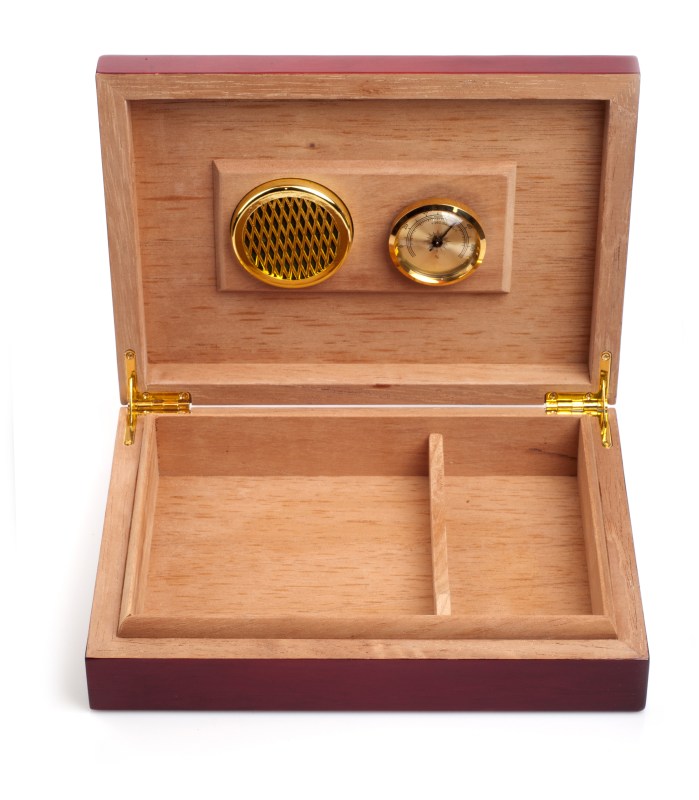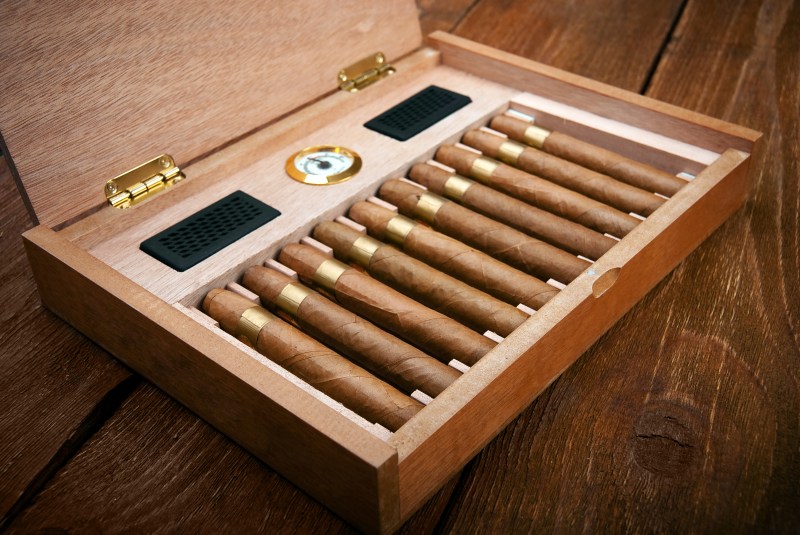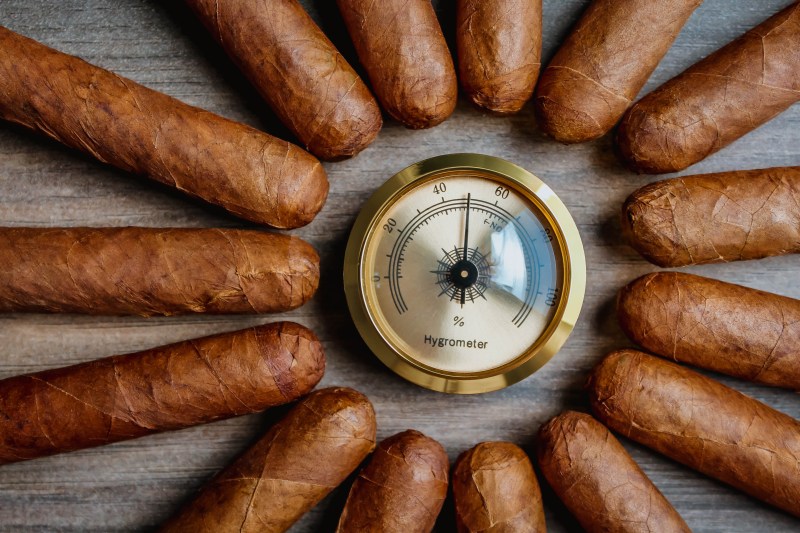If you’re a newcomer to the world of cigars or just bought a brand-new humidor, you’ll need to season it. And no, I’m not saying to add salt and pepper to it. If you’ve never heard of it, you might ask, “What is seasoning for a humidor?”
Don’t think you need to flavor the box or anything — seasoning is really about getting the wood inside your humidor so as not to rob your cigars of precious moisture. Easy to understand, and getting it done is relatively straightforward as well. The trick is figuring out the “why,” and we’ll get into that in a bit. But let’s first discuss seasoning a humidor.
How do you season a humidor?

Usually, wood from a newly bought, brand-new humidor is as dry as possible — bone-dry, really. The most widely used wood in humidors is cedar, and it’s very, very thirsty. If you were to toss your cigars into an unseasoned humidor that has a humidification unit, that wood is going to draw every bit of moisture into it before it even has time to go into your cigars or your humidification unit.
This is why seasoning is essential — it pre-wets the wood, preventing it from robbing your cigars or humidification system of moisture.
You don’t season randomly, though. You want to ensure that you’ve wiped down the inside of the humidor using a dry, clean cloth to remove any debris or dust from the manufacturing process. You also need to consider what method you’re going to use, and let’s discuss several options for you.
When seasoning a humidor, particularly larger ones filled with a lot of cedar, patience is necessary. The time it takes varies, but taking shortcuts can cause it to warp, turn moldy, or develop other problems that might ruin your investment. Typically, you can be sure that your humidor is seasoned when you’ve reached an even relative humidity on your hygrometer of about 65-72% for an extended day or two or perhaps even three.
I’ve also experienced episodes where I was convinced that I’d seasoned mine, yet the levels of relative humidity continued to drop — that means you need to let it have more time. Seasoning is generally effective in helping you control humidity in the long run, most of the time.
Why season your humidor?

A couple of valid reasons exist. The most apparent reason that we’ve sort of brushed against is that dry wood is going to draw water, and you don’t want that to dry your cigars, especially if you plan on keeping them in it for an extended period.
Some actually suggest re-seasoning a humidor every few years, especially if it’s been empty for quite some time. I don’t do that unless it’s absolutely necessary, but like anything cigar-related, it’s up to you.
Another reason that people season humidors, and this one is considerably more debatable, is that they’re attempting to recreate the environment within. In moderation, it’s best to keep humidity levels at an even baseline, but that isn’t always an option.
People relocate to different climates or adjust their target humidity level, and sometimes others need to start from scratch after experiencing mold issues. Whatever the case, re-seasoning the humidor is an option if done correctly. I don’t always suggest it, but appropriate seasoning is one of the best methods to accomplish it.
The wipe-down method vs. the bowl method

Just as most don’t approve of relighting cigars, some disapprove of using the wipe-down method of seasoning. I’m not one of them. In fact, I frequently use the wipe-down method, depending on whether I need it quickly. It won’t correct extreme problems in an inexpensive humidor; a poorly-constructed one will never retain humidity well, and seasoning won’t correct it either.
To use the wipe-down method, you will need distilled water, not tap water, which contains minerals and chemicals that could harm your humidor or cause mold to grow. Dampen (don’t soak) a lint-free, clean cloth in distilled water and gently rub down all of the cedar surfaces, such as the trays and dividers. Don’t scrub or wet the wood. Just create a light coating of moisture on it.
Next, add a shot glass or small bowl of distilled water, close the lid, and let it sit for 24 to 48 hours. Check your hygrometer and repeat as needed until your humidity level stabilizes.
The bowl method is more straightforward, but it is time-consuming. Place a small bowl or shot glass of distilled water in the humidor (or a wet sponge inside a plastic bag to avoid direct contact with the wood) and close it up, waiting 3-7 days. This is a more passive method that avoids the danger of getting wood too wet, but it demands more patience.
Why does it work? You’re allowing the wood to reach equilibrium with the humidity inside the humidor. Once it reaches that point, it won’t be fighting for your cigars over water. Whether there’s science to back up any of the specific methods, I don’t know, but it definitely works.
Calibrating your hygrometer

This is an absolutely necessary process that you shouldn’t sidestep. Check that your hygrometer is accurate before you even season. The most universal check is to use the salt test — put your hygrometer in an empty bottle cap or small cup filled with salt which has just been dampened (not dissolved) using just a few drops of water.
Seal the bottle or cup and let it sit for 8 to 12 hours. The inside should maintain a precise 75% humidity level. Check your hygrometer and adjust if it reads otherwise.
Digital hygrometers can be calibrated, while analog hygrometers may need you to memorize the offset. In either case, it is essential to know the accuracy of your hygrometer in order to season your humidor successfully.
Patience is key

Sometimes, it’s just not possible to save a poorly constructed or low-quality humidor, such as one with loose seals or made of cheap wood. You can also ruin a humidor by introducing too much moisture too quickly, just remember that. I still can’t understand why most people rush this process, but to each one’s own, I guess.
The fact remains, just remember that seasoning works, but it isn’t always going to save everything. You can never go wrong by giving your humidor an appropriate resting time before you store your cigars, and if it keeps those optimal humidity levels you desire, well, great. When your humidor is well seasoned, add your humidification device, allow it to stabilize for an additional day, and you’re ready to store your cigars.
Keep in mind that you want to achieve a stable environment, generally 65-72% relative humidity and approximately 70°F, although individuals prefer what works best for them. Proper seasoning of your humidor is the key to proper cigar storage. Do it well, and it’s well worth it: your cigars will reward you with an ideal burn, rich flavor, and overall improved smoking experience.




